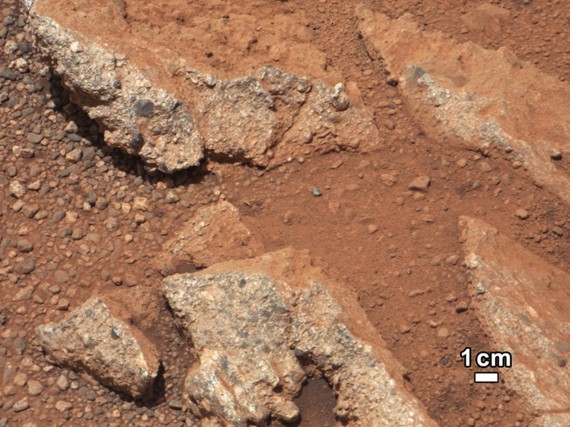Curiosity Rover Finds Proof That Water Once Flowed On Mars
The Mars Curiosity Rover has found evidence that liquid water once flowed on the surface of Mars:
NASA’s Curiosity rover has found definitive proof that water once ran across the surface of Mars, the agency announced today. NASA scientists say new photos from the rover show rocks that were smoothed and rounded by water. The rocks are in a large canyon and nearby channels that were cut by flowing water, making up an alluvial fan.
“You had water transporting these gravels to the downslope of the fan,” NASA researchers say. The gravel then formed into a conglomerate rock, which was in turn likely covered before being exposed again.
The agency’s scientists presented their findings of the former streambed on Mars at a news conference today.
“A River Ran Through It,” Curiosity’s operators tweeted Thursday. “I found evidence of an ancient streambed on Mars, similar to some on Earth.”
“From the size of gravels it carried, we can interpret the water was moving about 3 feet per second,” said Curiosity science co-investigator William Dietrich, “with a depth somewhere between ankle and hip deep.”
The rocks have not undergone scientific analysis. But the NASA team says that taken with geographic data from Mars orbiters, the photographs tell a story all their own.
The images show rocks with round, smooth surfaces; many of them have been broken down into sizes smaller than one inch in diameter.
“The shapes tell you they were transported and the sizes tell you they couldn’t be transported by wind,” co-investigator Rebecca Williams said. “They were transported by water flow.”
Scientists have not yet estimated the age of the rocks, which may have been buried beneath the surface. Their age could be several billion years.
The idea that there was once flowing water on Mars has intrigued scientists ever since astronomers started looking at the red planet through the more powerful telescopes that came into being in the 19th Century. At the time, it was thought that the lines seen on the surface were the signs of actual flowing rivers, a theory that no doubt led to the vast amount of Science Fiction literature that speculated about Martians visiting Earth. In all likelihood, though, the stream beds that Curiosity seems to have discovered were likely dried out hundreds of millions, if not billions of years ago. Nonetheless, where there is water, at least here on Earth, there is always some form of life. Could it be possible that we’ll find the fossilized remnants of some kind of Martian lifeform in this, and other, stream beds? One can only hope, because then our entire understanding of the universe we live in will be transformed significantly.
Photo via NASA






FTFY
@Franklin:
There. Refixed that for you, Doug.
@Eric the OTB Lurker: Sarcasm is wasted on some people.
Wow, who could’ve guessed that water is the only flowing liquid in the universe!
In all seriousness, even tho it is in all likelihood that this was done by water, I am a little surprised by the scientifically sloppiness of the statement.
@OzarkHillbilly:
True, it doesn’t have to be water, but there aren’t that many chemicals that naturally occur in large amounts in our solar system that are liquid in a broad enough range to stay liquid for long enough periods of time, at temperatures likely to occur on Mars.
CO2 is only a liquid for a spread of about a dozen kelvin. That is too unstable to form real streams. There is a lot of methane out in the gas giants, but it’s boiling point is too low.
@Franklin:
Unlikely. If there was water on Mars then it had to have existed during a time when the planet’s surface temperate was warmer than it is today. By all accounts, Martian temperatures have been low ever since the planets atmosphere became as thin as it is now due to exposure to the solar winds. Unlike Earth, there is no Martian equivalent to the Van Allen Radiation Belt. Or at least it doesn’t now.
@Ben:
Agreed, and this would have had to have been a liquid that stayed in that state for a long enough period of time that it caused stones to be transported and shaped due to erosion.
There are still a lot of questions to be answered, obviously. However I think that with this discovery Curiosity has already paid for itself.
Pretty damn cool no matter how you slice it. When I was a kid, the nature of the martian surface was a mystery – how many countless generations lived and died looking up at the sky, wondering what it was like up there.
We get to be the ones who find out. I say we increase funding for these types of missions.